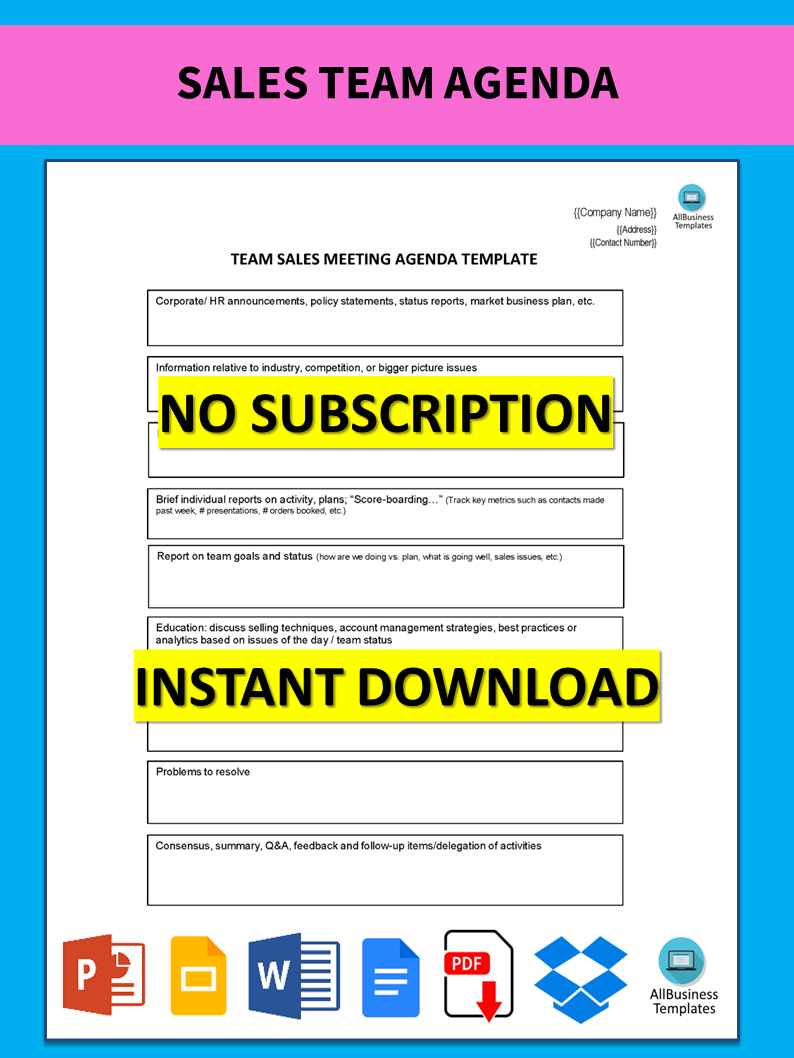Sales Team Agenda
Save, fill-In The Blanks, Print, Done!

Download Sales Team Agenda
Microsoft Word (.docx)Or select the format you want and we convert it for you for free:
- This Document Has Been Certified by a Professional
- 100% customizable
- This is a digital download (24.9 kB)
- Language: English
- We recommend downloading this file onto your computer.
How do you create an agenda for a sales team that is professional? Do you need a template of a sales team agenda? Here is one of our sample templates that can assist you in strategizing and coordinating your team’s actions in a much better way. In case you want it just click on the link and modify it according to your desire.
A sales team agenda is a formal strategy or draftsman used to help discussions and activities in the sales team meeting. It guarantees that the meeting remains focused, all vital areas are considered and it allows effective communication as well as decision-making among the members of the team. There is often a list of topics, time schedules, and target points summarily included in such an agenda.
Making a professional sales team agenda:
An efficient sales team agenda requires meticulous planning and awareness of what to do in each meeting. Below are some tips on how to make such an effective, simple, and effective sales team agenda, which is aligned with the goals of your team.
- 1. Understand the Purpose of the Meeting
- Define your Objectives: You need to know precisely what it is you want from this meeting (for instance, review performance, look at new strategies, or address some challenges).
- Set Forth Clear Goals: Decide on specific outcomes expected from this meeting including; decisions on strategies, updates about sales targets, or how to handle an action plan.
- 2. List down Key Agenda Items
- Brainstorm Topics: Write down all important topics that require discussion and relate them to meeting objectives
- Prioritize: Organize these topics according to importance so that the most critical items come first
- 3. Assign Time Allocations
- Estimate Time: Give each agenda item a realistic timeframe depending on its complexity and significance.
- Balance the Scheduler: Ensure that the amount of time for each item permits an exhaustive discussion but at the same time ensures that meetings proceed within reasonable limits.
- 4. Identify Responsibilities
- Assign Leaders: Delegate each agenda item to a specific person in charge who will be responsible for presenting relevant information and controlling the discussion.
- Include a Note-taker: A person should be appointed to note during the meeting, taking down important points, decisions made, and actions to be taken.
- 5. Prepare Supporting Materials
- Gather Resources: Bring together reports, data or any documents that will back up the conversation on every agenda item.
- Pre-Distribute Materials: Distribute these documents together with the agenda beforehand so that team members will read them and prepare themselves accordingly.
- 6. Draft the Agenda Document
- Professional Formatting: Insert headers hence formatting it nicely and in an organized way; use bullet points type listing among the rest of formats required in a professional document outline. This may involve including company trademark identification elements such as logo or color scheme if necessary.
- Include Key Details: Within this section please indicate information about the meeting date, time, and venue (or virtual platform) at the beginning of your agenda.
- Participants: List attendees so that everybody is aware of who is going to be there.
- 7. Go over everything and finish it.
- First, look over the draft order of events for any mistakes that you might have made. Together with this, make sure that it is understandable, short, and proper.
- Promptly distribute it: have all attendees received an advanced copy of the full agenda before the scheduled date of the meeting? In so doing, everybody gets ample time to prepare themselves and becomes aware of what is expected from them.
- 8. After a conference call Follow Up
- Distribute Minutes- Once a conference call is over; circulate notes of the meeting which capture significant aspects such as decisions made and assignments given to ensure accountability.
With this particular arrangement, one can be guaranteed that the gathering will be directed to the point, done professionally, and will produce much output, ensuring the team achieves its sales plan.
Enhance productivity by clicking on ‘Open with Google Docs’ or downloading now our sample sales team agenda template as a Word template!
DISCLAIMER
Nothing on this site shall be considered legal advice and no attorney-client relationship is established.
Leave a Reply. If you have any questions or remarks, feel free to post them below.
Related templates
Latest templates
Latest topics
- GDPR Compliance Templates
What do you need to become GDPR compliant? Are you looking for useful GDPR document templates to make you compliant? All these compliance documents will be available to download instantly... - Google Docs Templates
How to create documents in Google Docs? We provide Google Docs compatible template and these are the reasons why it's useful to work with Google Docs... - IT Security Standards Kit
What are IT Security Standards? Check out our collection of this newly updated IT Security Kit Standard templates, including policies, controls, processes, checklists, procedures and other documents. - Letter Format
How to format a letter? Here is a brief overview of common letter formats and templates in USA and UK and get inspirited immediately! - Google Sheets Templates
How to work with Google Sheets templates? Where to download useful Google Sheets templates? Check out our samples here.
cheese

